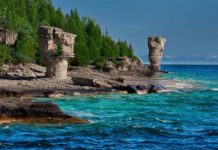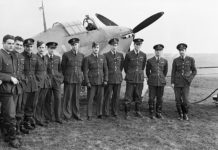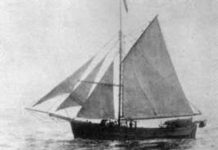In 1898, two young miners found placer gold on Pine Creek in northern BC. The gold rush was on, and the town of Atlin swelled into a boom town.
Perhaps with tingles of excitement, two young men stood in the government’s Registry Office on July 30, 1898. Staking their rights, Kenny MacLaren and Fritz Miller claimed land overlooked by snowy mountains, grassy meadows and the burbling of rivers. Swishing with the water and silt in their pans was gold. News of the precious rocks found in Pine Creek at Atlin, BC spread like wildfire. Men already en route to the great1898 Gold Rush of the Klondike detoured to Atlin to make their fortunes with the precious yellow rocks.
“It wasn’t long before thousands of gold-seekers descended on the eastern shore of Atlin Lake,” said Atlin Centre’s History and Climate of Atlin, BC. The optimistic gold miners were “hauling tons of supplies over mountains and across Atlin Lake – by boat in summer and by sled, often over unsafe ice, in winter.”
Only a stone’s throw from the Yukon border in northern British Columbia, there was a technical problem – the Government Agent and Gold Commissioner at the time were not sure if Atlin was located in BC or part of the Yukon Territory. The claims were filed under Yukon law. Nearly the “wild west,” British Columbia law did not recognize the Yukon titles and grief was caused for Miller and McLaren. The territorial and provincial boundaries were finally determined, and the miners went on with their exciting discoveries.
Atlin Founded on Placer Gold
With the rush of placer gold miners, Atlin blossomed into a town of 10,000 residents. Making their homes in rough shanties and uncomfortable tents, mining spread 12 kilometres eastward to a boom town appropriately dubbed “Discovery.” (Placer gold is gold that is loosened from its hard rock position by weathering, water or glacier activity, and often washed into concentrated deposits. It usually is not far from the original hard rock.)
The miners needed supplies and supports, and entrepreneurial men and women of Atlin opened stores and hotels, a theatre and, as it seemed every mining town needed, a brothel on the outskirts. Homes were constructed and the essential social structures were built: churches, a one-room schoolhouse, a hospital, a courthouse and jail, and a mortuary.
Millions in Gold Mined in Atlin Fields
The name of Atlin was a mispronounced native word,“Ah-lah,” meaning “stormy weather.” The town’s gold rush “was one of the richest offshoots of the Klondike rush, said the BC Government’s Ministry of Environment, and by 1899, “Atlin was a busy and important town.”
Winding down, the gold boom in the area dissipated by 1908, but over a century later, there are still valuable finds to be made in the Atlin gold fields. Over the decades, more than $23,000,000 in placer gold has been mined there, according to the Ministry of Environment.
Exploring the Llewellyn Glacier
Eventually, the prosperous mining settlers dispersed, the impermanent buildings crumbling into dust. Nature reclaimed portions of the once-bustling town but it was not completely devastated. Tourism kept visitors coming to northern British Columbia. The nearby Llewellyn Glacier was a popular sight for climbing and exploring. Cruising the crystal-blue, sparkling Atlin Lake on the MV Tarahne was another treat. Commenced in 1917, the boat tour operated until 1936.
Nearly a ghost town in 1960 with a population of only 100, Atlin now is home to about 500 residents. The present-day citizens are a creative lot. The small town is thriving with artists, gold miners, bush pilots and even retired academics, said the Atlin Centre. The Taku River Tlingit aboriginals live in the region, the area rich in native history. The Atlin Provincial Park and Recreation Area is home also to wolves, mountain goats, grizzly and black bears, moose and caribou, and features a Lake Trout Fishery.
The wealth of Atlin may have begun with pans of glittering gold in the hands of miners MacLaren and Miller, but its future lies in the striking natural beauty of northern British Columbia.







